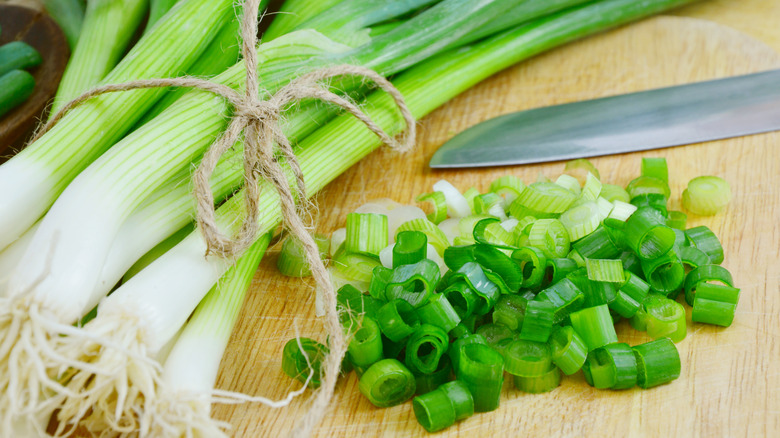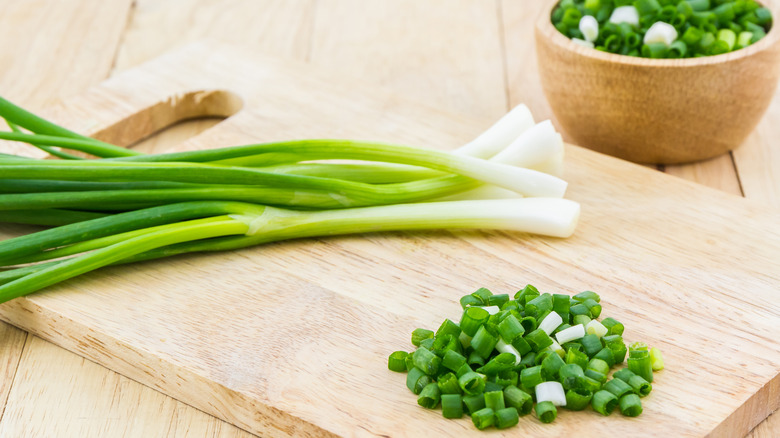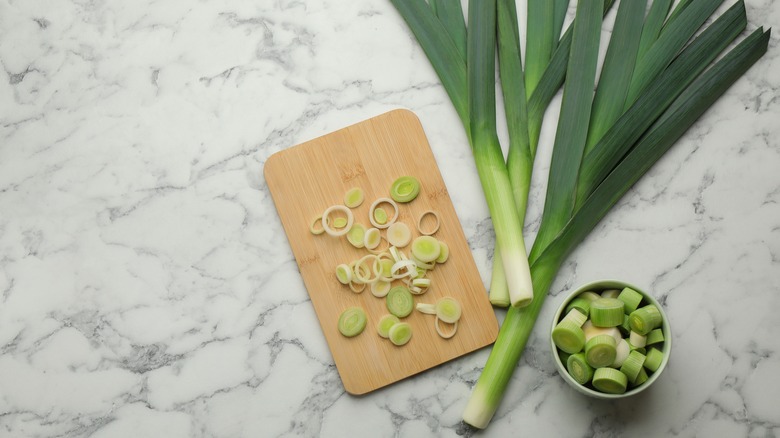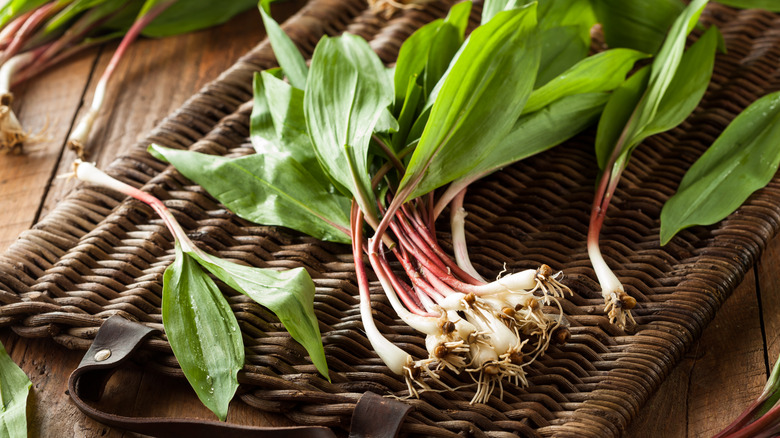The Differences Between Scallions, Ramps, And Leeks
If you've ever been perplexed while scanning the produce aisle by the vast array of long-stemmed, green, onion-type varieties, you're not alone. From onions and shallots, to garlic and chives — to scallions, ramps, and leeks — the fancy name for this familiar family of vegetables is alliums. While allium is the Latin word for garlic, it's more of an umbrella term for a very large extended family. While they may seem a little mysterious, odds are you consume one of its members in some form or another on a daily basis (via Food Revolution Network).
Watery eyes while chopping may be one of their less desirable side effects, but alliums come with a whole host of culinary and health benefits. They have antiviral and antimicrobial properties, are a great source of antioxidants, and may even boost our immune system. When it comes to the kitchen, each member of the family offers a flavorful addition to any dish. For the most part, they impart a similar flavor, but each is unique in its own right.
Scallions, leeks, and ramps are a few of the more often confused alliums. They look alike, but each deserves its own deep dive. What are the differences between the three, and what dishes are they best suited for?
Scallions simplified
Although they're also called spring onions, scallions are available year-round. The slim green and white shaft is merely the leaves that grow above ground as an onion forms. Scallions have a mild onion flavor with a hint of sweetness, per myfoodbook.
Scallions are one of Asia's first crops and have been a staple in many Asian dishes since 3500 B.C. From dumplings to pad Thai to pancakes, to medicinal and therapeutic purposes as an herb, they were a revered crop in the continent. Today, they are grown and beloved globally for the subtle bite and pop of color they add to any plate (via Co+op).
Although all parts of the scallion are edible, the white and green parts have different flavors and are best suited for different culinary uses. The white parts have a stronger flavor and fare better during cooking than the green portion. The milder green parts are best added toward the end of the cooking process or used as a garnish. Both sections are delicious raw, often seen atop a salad but suitable for any dish you would like to add a subtle onion flavor to, per Simply Recipes.
The layered leek
Potato soup may come to mind when you first hear leek. That, or the massive undertaking that is cleaning one of the oversized, studier cousins of the scallion. Much like scallions, leeks have been consumed for ages. There are records of consumption by the Egyptians in the second millennium BCE, and leeks are mentioned in the Bible. Also similar to scallions, they grow year-round (via MasterClass).
The sturdy stalk of the leek that leads to its coarse, darker leaves is composed of several tight, concentric layers that resemble the rings of a tree trunk. However, those layers are notorious for harboring grit. The best way to remove the dirt is to slice the leeks and then soak them in a bowl of water. The grit will sink to the bottom while the leeks float to the top.
Leeks have a mild, sweet onion flavor and are a versatile addition to many dishes. While all parts of the leek are edible, the tougher, flat leaves (reminiscent of the fronds of a palm tree) are often discarded due to texture, per Homestead and Chill.
Unlike scallions, leeks tend to take on more of a substantial, starring role in a dish as opposed to appearing as a mere garnish. They can be enjoyed raw or cooked but are typically enjoyed after some form of cooking. Popular culinary applications see leeks pureed with potatoes into a soup, known as the French classic vichyssoise, incorporated into sauces and vinaigrettes, simply sautéed or caramelized in butter as a side dish, or transformed into a quiche.
Ramps are a seasonal delicacy
In a nutshell, ramps are wild onions or wild leeks. Only available for a short window in early spring, ramps are a cherished, cyclical, foraged favorite. While ramps resemble scallions, they taste different. They are closer in flavor to another prominent allium family member, garlic. Unlike scallions and leeks, ramps are anything but mild. They take on a flavor that's much like an amalgamation of many other alliums — such as onion, garlic, and scallion — making them a powerful addition to any springtime dish, as noted by Good Housekeeping.
In addition to their unique taste, they are also markedly different in appearance from their leek and scallion cousins. Upon first glance, they may appear like a dainty, flexible, leafier scallion, but with further inspection, you'll often find a beautiful, deep, pinkish-purple hue in their stalks and leaves, per Farmer's Almanac.
Ramps are best added to heartier foods like potatoes and eggs but are much-loved in their simple, raw form as a peppery pesto. All parts are edible and enjoyed cooked or raw. Their season is fleeting, found for just a few weeks starting in mid-to-late April in the eastern half of the United States.



